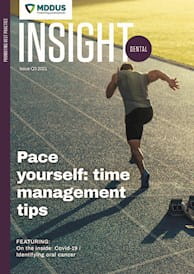
Dr Amy Walker shares her experience of a clinical error that profoundly changed her practice and which provides key lessons for both medical and dental professionals
HAVE you ever made a mistake at work? Not a little one, but really quite a big one?
When I was working as a clinical fellow, I made a mistake that, seven years on, I still think about often. I would like to share what happened with you because this experience shaped my practice and sparked my interest in human factors.
 I had not long arrived in a new hospital, fresh from a year working with a leading expert in the field of ultrasound-guided nerve blocks. I had been put down to work in the orthopaedic theatre alone and my patient was a little girl who needed extensive surgery to her forearm and hand.
I had not long arrived in a new hospital, fresh from a year working with a leading expert in the field of ultrasound-guided nerve blocks. I had been put down to work in the orthopaedic theatre alone and my patient was a little girl who needed extensive surgery to her forearm and hand.
My plan was to do an interscalene block (put local anaesthetic around the nerve plexus in the neck). I had done a couple before and seen many more, but not yet performed one unsupervised. I was pleased to be on my own, I could take my time, properly visualise the anatomy and not have to worry about teaching anyone else.
Shortly before the list started I was asked to take a junior SpR on my list and of course I agreed; I couldn’t really say no. We put the little girl to sleep and I started to prepare my equipment for the block. It became apparent that there was no trolley to put my kit on so I had to make do with laying things out on the side in the anaesthetic room.
A particularly difficult colleague who wanted me to change something for her on the on-call rota interrupted me during this process.
With the great benefit of hindsight, one can see the holes in the Swiss cheese starting to line up.
Do not approach
At last I was ready to place my block. And it went perfectly. I was able to see the anatomy beautifully, my needle placement was spot on and I happily watched the local anaesthetic surround the nerves. A textbook block; I was delighted. Until I wheeled the child into theatre and it dawned on me that I had put it in on the wrong side.
And what made it worse was that my ODP (anaesthetic assistant), newly qualified and excellent at her job, later told me that she knew I was putting the block in the wrong side. Why didn’t she tell me?
Well, looking back I think that the change of plan, the lack of what I considered to be appropriate equipment and the irritating distractions had put me on edge. My body language changed, my tone of voice changed, everything about me now said ‘irritable, do not approach.’
She didn’t tell me because in a few short moments I had dramatically steepened what was usually a shallow authority gradient.
Effective interactions
Phil Higton of risk training consultancy Terema discusses how “approachability” is key to creating positive team dynamics
 In our professional lives we often work with others. Sometimes as a formal team but more often as a group trying to solve a problem or make something happen. We think that we know how to make these interactions effective, but have rarely been taught how.
In our professional lives we often work with others. Sometimes as a formal team but more often as a group trying to solve a problem or make something happen. We think that we know how to make these interactions effective, but have rarely been taught how.
In teaching human factors we use a structure called the NASA Team Skills to explore the dynamics of team (or group) interactions. There are eight of these in the matrix but one, ‘Interpersonal Relationships and Group Climate’ acts as the gatekeeper to the rest. If well-managed, it makes many things possible. If poorly managed, all activities and interactions are compromised.
Personal vs professional relations
Underpinning this vital skill are two representations of ‘me’.
Interpersonal relations are fundamentally about the social me, with all the unspoken social and cultural expectations which represent self-worth. In a group, we are united by our collective humanity and respectful of differences.
On the other hand, group climate is a representation of the professional me. The notion of climate reflects the display of consistent and consistently professional behaviours in the workplace. I suspect that we have all worked with someone whose behaviour is volatile, even in a high-risk environment and have insight into how we have responded.
Positive dynamic
We know from studies of team dynamics that every individual will make a difference to the dynamic simply by being present. The challenge is to make a positive contribution and avoid behaviours which have a negative impact.
What are the big things?
1. Psychological safety
Without this, we become self-protective and withhold information, co-operation and initiative. Its key attributes are:
- Do I feel welcome?
- Do I know what is expected of me?
- Do I know what the rules of engagement are?
- Do I know who to approach to get help?
2. Incivility (rudeness)
You may be aware of a campaign under the banner of ‘Civility Saves Lives’ which has highlighted an increasing number of studies which have sought to quantify the negative impact of rudeness on team performance and outcomes. The figures are truly shocking. Being the direct recipient of rudeness reduces our mental bandwidth by 61 per cent, with a huge impact on our professional performance. The reduction can last for hours or days as we lick our wounds.
Unfortunately, it doesn’t stop there. Onlookers have their performance affected too. Studies show that they are 50 per cent more likely to miss a calculation error and 50 per cent less likely to help others. Incivility is simply contagious. It corrodes psychological safety.
3. Authority gradient
This relates to the perception of power differences between individuals. In any group interaction it is the individual with the most power who exercises control. Sources of power are many and varied and many are situationally dependent. If the difference in power is small, we refer to this as a shallow gradient. Information sharing, involvement and engagement are all facilitated.
With a steep gradient, the difference in power is large, the most powerful person becomes isolated from the group. Less powerful group members become reluctant to share information and initiative even in safety critical situations.
Critically, authority gradients are a perception; they are a reflection of the approachability or otherwise of the ‘boss’. This perception is informed heavily by non-verbal cues such as demeanour and appropriate eye contact. From a very early stage in our lives we become attuned to the signals which say ‘don’t approach, shut up, stay clear’ and, as with many things in life, negatives are hugely more powerful than positives.
Approachability is key
We have seen from Amy’s insightful story that even the best of us can unintentionally isolate ourselves from help.
Psychological safety matters and even if we were able to put aside the impact of incivility on the performance of other team members by expecting them to absorb any perceived rudeness coming their way, there remains a big problem. We judge the authority gradient by assessing the boss’s approachability in the moment. If your team perceive a steep authority gradient, they will stop sharing information. You will not find out what you are missing.
- Dr Amy Walker MBChB FRCA is a consultant in paediatric anaesthesia at Birmingham Women’s and Children’s Hospital
- Phil Higton is a former pilot and director of training at human factors training consultancy Terema
This page was correct at the time of publication. Any guidance is intended as general guidance for members only. If you are a member and need specific advice relating to your own circumstances, please contact one of our advisers.
Read more from this issue of Insight Dental

Save this article
Save this article to a list of favourite articles which members can access in their account.
Save to library
